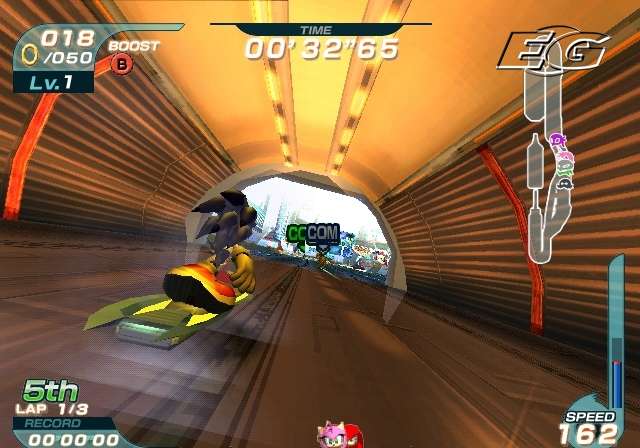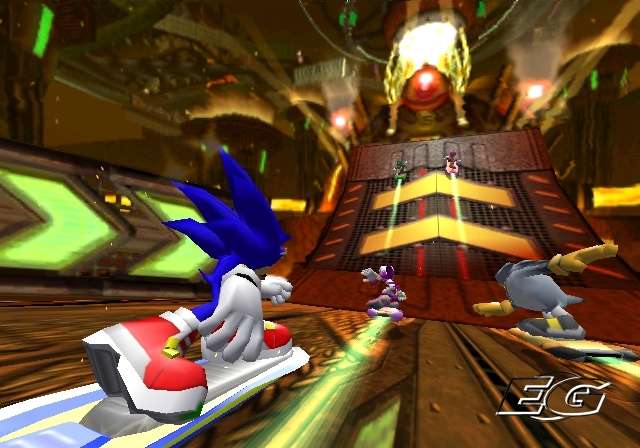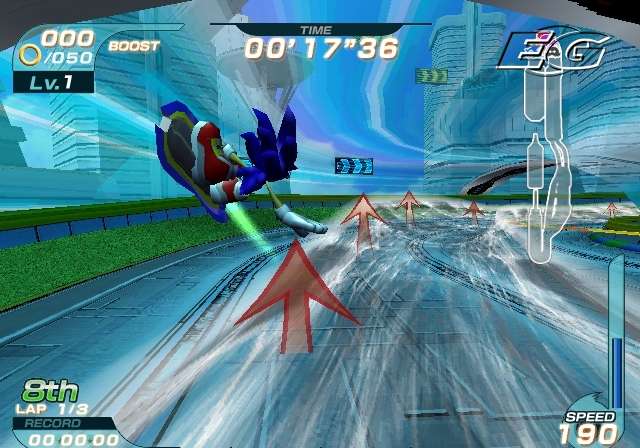Sonic Riders
Which is also my band name idea for Winona.
Sonic Riders begins as if upside down. Instead of cleverly introducing all its ideas one by one on the race track and relegating its paper-thin storyline to the manual (which is obviously made of paper and therefore ideally suitable), it stupidly spends ages introducing its paper-thin plot and relegates to the manual all the important details, like what the hell all the things on the screen mean, and how to turn corners without smacking repeatedly into the wall. (Incidentally, neither game or manual explains why Tails is still alive.)
And of course, apart from a brilliant bit where a hawk-lady makes Tails the-stupid-fox-who-I-hate angry, the cut-scenes are full of unnatural, second-language dialogue acted out by the usual crowd of unquestioning voice actors, who by now must be used to delivering sentences like, "These players, they're hot, the best racers I could find!" with an array of inflections previously uncharted by humankind. (In fact that's probably why the actors keep coming back for more work.) Anyway, since the game doesn't bother to tell you, I might as well give you an idea of how to play it.
Sonic Riders is a hoverboard racing game. In other words, a range of Sonic the Hedgehog characters (including some birdy types called the Babylon Rogues - yes, their back-story is the sort of thing that makes you wish you were five again so that you could beat yourself around the head with a spiky piece of wood for 18 hours for being so stupidly tolerant of things like this) zoom along on gravity-defying snowboards, building up speed by riding each other's wakes, boosting and hitting boost pads. And collecting rings. And building up air. And using pitstops. And grinding. And doing tricks. And levelling up. So there's quite a lot and it's a bit messy.
Initially though it's quite promising - instead of timing button presses like Mario Kart (or, well, most racing games), you try and time a run-up to the starting line so that you cross it at your top running speed just as the race begins. Go too soon and you get electrocuted and consequently held up; go a bit late, or slow down to avoid being electrocuted, and you may find the other races zoom past you. It democratises the traditional starting grid boost, which certainly deserves a paragraph's worth of credit.

Once you're on your way, the board handles as though on a bed of air - appropriately enough - and a re-employed elevator announcer lady smoothly informs you that you've landed badly, or screwed up a corner, or that you're in fifth (actually I've not figured out what she's saying; it sounds like "fifth" but since you're in first or seventh or whatever I'm not so sure). And to now draw upon that parenthetical (hopefully without anybody taking too much offence), your position really will be that random to start with. As soon as corners get a bit sharp, you need to use the triggers to lean into them a bit - apparently you're shooting out bursts of air to help turn you around - but you can also use the triggers simultaneously to do a tornado attack on those close to you. So bear that in mind.
Also bear in mind your "Air" bar down in the bottom right, because it holds the key to everything: clobbering enemies, using your boost, using your trigger-turns; while other key functions like tricks and pitstops are all feeding into it. Air is Riders' equivalent of F-Zero's boost/health bar, in a sense - run out of Air and you'll literally have to walk the rest of the way to the next pitstop, but keep plenty of it in stock and you can afford to boost if you're closing on a fellow competitor or you get the wind knocked out of you. Although that's a bad choice of wording, come to think of it.
The concept's right though - the main problem you face in Riders is maintaining speed, because holding a trigger-turn a fraction too long will see you hit the wall (and bounce along it), and there are countless obstacles, narrowing roads and even sheer drops to fall into as you make your way through the various tracks. With plenty of shortcuts, and a typically Sonic-esque "blindly running down shortcuts you never knew about" feel to quite a lot of it, you'll certainly take plenty of hits. Hence the need to keep the Air topped up.

So now you're wondering what the rings are for: well, collect enough and you level up, which increases your maximum attributes. And now you're blah blah blah tricks are for: well, as you jump (jump? That's A or X depending on your console), you can twist the left analogue stick around about to do flips and turns; land well and you net some more Air. Etc. etc. grinds are for: similar thing; using a "speed" class character, you jump and then hit the same button again on a rail to grind it. Di-dum-di-dum classes? Speed (Sonic) can rail-grind, flight (Tails gngnrh) can hover through acceleration-hoops; power (Knuckles) can bash through stuff without losing speed. Acceleration-hoops? Like power-ups, they give you a bit of a boost, and hang in mid-air in interesting places. Power-ups? Gah. Like Mario Kart, these offer rings, speed-boost, protection, etc.
Why does it have to be this complex? It's taken the best part of 1000 words (admittedly I could have shut up about the cut-scenes and Tails and that) to actually get you to the stage where any praise or criticism I fork over will make any sense. That's not good game design - and not introducing this stuff properly makes about as much sense as advertising infinitely better racing game OutRun 2006 on the back of the manual as if to say "you've played the nightmarishly complex sponging of the Sonic franchise, now play the best!" Seriously, if Sonic Riders had soundbites associated with it, they would be that convoluted.

Which is a shame because it's not actually a bad game once you get a grip on the track design. Build up a decent speed and keep it there and it's like playing chicken in a wind tunnel on LSD or some other ludicrous drug-related metaphor. Manoeuvring between routes at speed, trying to pick out shortcuts, and - easily the game's most intriguing idea - riding people's wakes, or turbulence. I didn't mention this earlier precisely because I wanted to harp on about how interesting it is: basically, when somebody's zipping along ahead of you, their wake forms a big cloudy half-pipe - like the trails from an aeroplane, except on the track in front of you - and as long as you can stay on it you can effectively ride right up to them and leapfrog them in position. Except, they can then do it to you. Coupled with the speeds you move at, and all the other various bits and pieces you're trying to keep track of, it can make for a very varied and interesting race, however many times you've been around that track.
But then the operative word here is "can". Occasionally Riders is very fluid and exciting, and you can almost see the ghost of old-days Sonic the Hedgehog peeping out as you move between branches and try to stay in control. But for the most part, it's overly complicated, and dominated by things designed to stop it being fluid and exciting. And after a while, whenever you bounce off a wall or stop dead in a pitstop you didn't need or mean to go into, and that woman loudly explains how rubbish you are, you stop noticing the good things. Rather like the way the game forces you to the manual in search of explanation only to find an advert for a better racing game, it's unapologetic about ruining things for itself.


